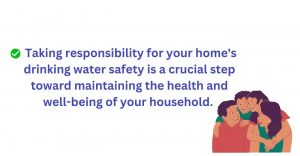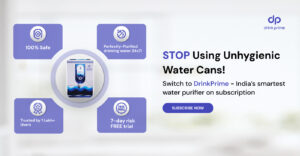Is the water you drink safe?
Maintaining your health greatly depends on making sure your drinking water is safe. Concerns about water quality are becoming more widespread, so it’s critical to be proactive in ensuring that the water coming from your tap is safe. Both visible and unseen toxins could endanger your health.
This is why it is critical to educate yourself about the various contaminants, including chemicals, heavy metals, and microorganisms, that may infiltrate your water supply.
We’ll review how to do easy tests for discolouration or foreign particles in your water. We’ll also discuss the significance of your water source’s safety and any possible hazards.
By arming yourself with information and appropriate resources, you can answer the question, “Is your drinking water safe?” and take proactive measures to protect your health and those of others you care about.
Let’s get started!
Is your drinking water safe? Why is it crucial to verify the safety of your water?
Ensuring your drinking water is safe is essential to your health and well-being. Regular water intake is essential for sustaining bodily functions, and any pollutants or impurities might have detrimental effects. Checking the safety of your drinking water is crucial for the following reasons.
- First and foremost, serious health dangers are associated with drinking contaminated water. When water supplies are not properly managed, waterborne illnesses, including cholera, typhoid, and gastrointestinal infections, can spread quickly, particularly in susceptible groups such as children, the elderly, and people with weakened immune systems; these infections cause acute dehydration, hospital stays and even death.
- Furthermore, drinking contaminated water causes long-term negative health repercussions. Certain pollutants, such as industrial chemicals (like pesticides and solvents) and heavy metals such as lead and mercury, have been connected to chronic conditions, including developmental delays, cognitive decline, and various types of cancers. Making sure the water you drink is completely safe and clean is crucial because these health problems might not appear immediately but over time.
- Verifying the safety of drinking water also gives people the power to make wise decisions. People can address any issues by taking the proper action if they know the quality of their water source. To address possible causes of contamination, this may entail utilising water purifiers.
The best part is personal actions in determining water safety contribute to the welfare of the community. When people put their drinking water safety first, it might encourage their neighbours and the community to take similar precautions. This collective effort will improve overall water quality and lower the dangers of waterborne illnesses. In this manner, the question becomes “Is everybody’s drinking water safe?”
7 Ways To Verify the Safety of Your Drinking Water
Even when tap water is being treated, precautions must be taken to guarantee its safety. Here are seven methods you can use in the convenience of your own home to verify the safety of your water:
1. Visual Examination
Examine your water visually first. If it seems discoloured or contains visible particles, it can indicate contaminants. Unusual appearances indicate a problem with your drinking water, but clear water does not guarantee safety.
2. Odour Test
Have faith in your nose. If your water smells strange, it may be contaminated. While a musty odour may indicate the presence of undesirable substances, a strong chlorine scent may result from over-disinfection.

3. Taste Exam
Your water may be contaminated if it tastes off. A metallic or bitter taste may indicate the presence of minerals or contaminants.
4. Examine the Texture of Hard Water
White residue may be left on faucets and surfaces by hard water. Such residue indicates that your water has a lot of minerals. Hard water may not be dangerous in the near term but can lead to serious health problems over time.
5. pH Testing
Water’s flavour and mineral absorption capacity might be impacted by pH levels. The optimal pH level for drinking water is between 6.5 to 8.5 and test kits are easily accessible. Extremely low or high pH readings are undesirable and necessitate additional testing.
6. Kits for Home Water Testing
One of the greatest methods to respond to the question, “Is your drinking water safe?” is this. Numerous thorough testing kits can be purchased locally or online. Numerous pollutants, such as bacteria, lead, pesticides, and more, can be analyzed by these kits. Keep in mind that these tests frequently yield more accurate findings than basic testing or visual checks.
Get 7 Days Risk Free Trial
Conclusion

By using these techniques on a regular basis, you can identify possible problems with your drinking water early on. A combination of tests is advised for a more comprehensive evaluation because certain pollutants may not be perceptible to the unaided eye, nose, or taste receptors. Seek advice from experts or get in touch with your local water authority if you have questions about the findings or believe there may be serious contamination.
In conclusion, one of the most important things you can do to keep your family healthy and happy is to take responsibility for the safety of the drinking water in your home. You can make sure that the water you and your family drink is of the best quality and devoid of dangerous pollutants by implementing these seven techniques into your daily routine.
FAQs
What would be the best way to obtain safe drinking water?
The best way to obtain safe drinking water is through reliable filtration methods like reverse osmosis (RO), UV purifiers, or activated carbon filters. Boiling is also effective for killing pathogens. Always ensure your water source is clean, and consider regular water testing to check for contaminants. Subscribe to DrinkPrime monthly plan now!
What are the qualities of good water?
Good water should be clear, odourless, and free from harmful contaminants like bacteria, heavy metals, and chemicals. It should have a balanced pH level (around 7), be free of any unpleasant taste, and contain essential minerals for health. Safe, clean water supports hydration and overall well-being. DrinkPrime provides free, detailed water quality reports before and after purifier installation.
What are the sources for drinking water?
Common sources of drinking water include groundwater (wells and boreholes), surface water (rivers, lakes, and reservoirs), and municipal supply systems. Bottled water and rainwater harvesting are also alternative sources. It’s important to ensure these sources are clean and properly treated for safe consumption. DrinkPrime ensures this by providing the water quality insights.
What is the importance of water quality?
Water quality is crucial for health, as contaminated water can cause diseases and affect overall well-being. Safe, clean water supports hydration, helps in digestion, and ensures proper body functions. Maintaining good water quality is essential for preventing waterborne diseases and promoting a healthy lifestyle. DrinkPrime offers comprehensive, free water quality reports both before and after the installation of the purifier.
What causes unsafe drinking water?
Unsafe drinking water can result from contamination by bacteria, viruses, heavy metals, chemicals, or pollutants. Sources like untreated wells, polluted rivers, or faulty water treatment systems can introduce harmful substances, leading to serious health risks. Proper filtration is crucial to ensure safety. With DrinkPrime water quality report, you'll know the effectiveness of the purification process.
How important is clean water?
Clean water is crucial for overall health as it prevents waterborne diseases, supports digestion, boosts immunity, and maintains hydration. Contaminated water can lead to serious health issues, making access to safe, clean water essential for well-being, energy, and proper bodily functions. Get safe drinking water with DrinkPrime!




